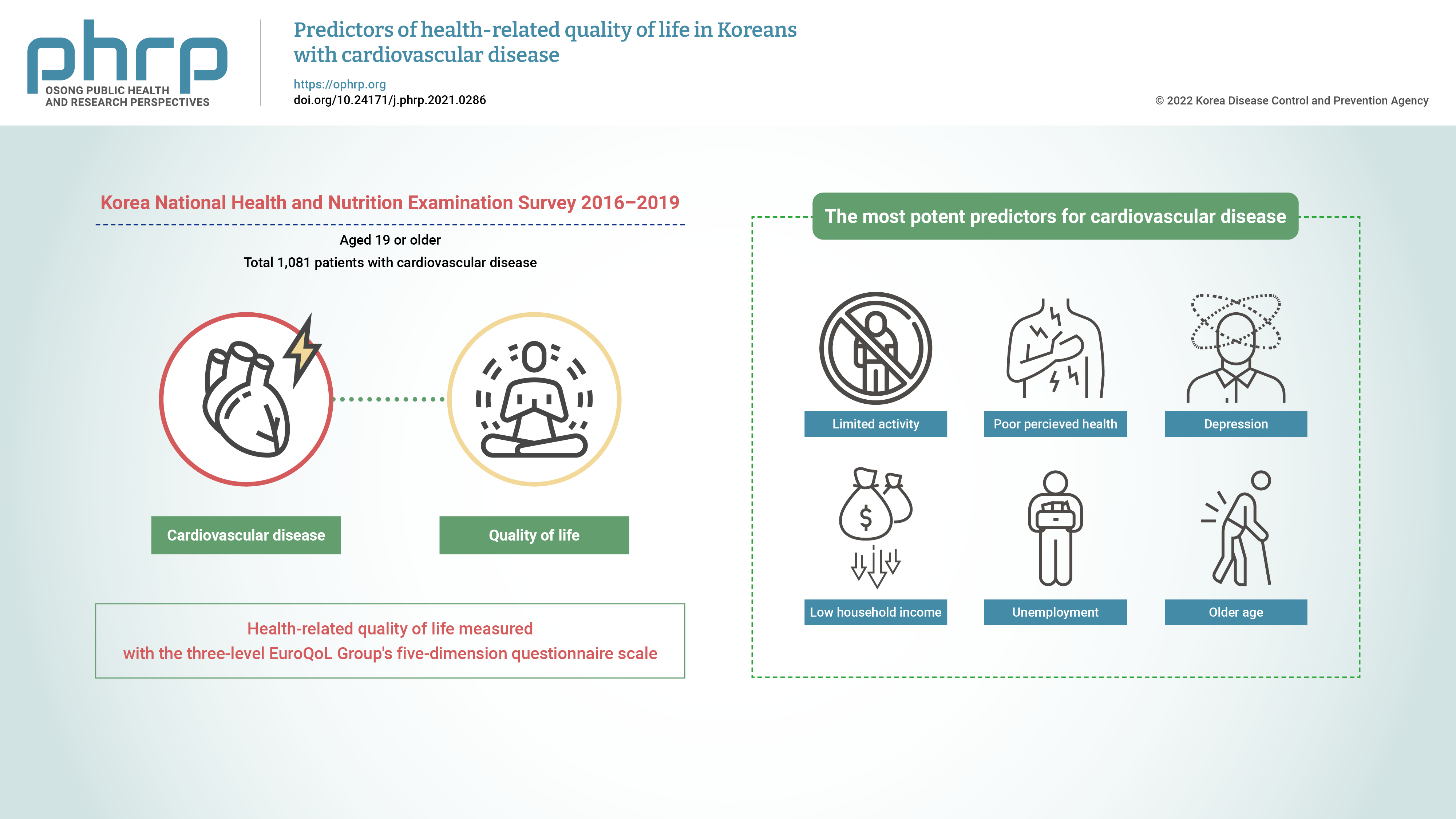Search
- Page Path
- HOME > Search
Original Articles
- Predictors of health-related quality of life in Koreans with cardiovascular disease
- Jung-Hye Lim
- Osong Public Health Res Perspect. 2022;13(1):62-70. Published online February 22, 2022
- DOI: https://doi.org/10.24171/j.phrp.2021.0286
- 3,955 View
- 86 Download
- 1 Web of Science
- 1 Crossref
-
 Graphical Abstract
Graphical Abstract
 Abstract
Abstract
 PDF
PDF 
- Objectives
This study aimed to identify the predictors of health-related quality of life (HRQoL) in Korean adults with cardiovascular disease (CVD). Methods: This was a cross-sectional study with a stratified multistage probability sampling design. Data from the 2016 to 2019 Korea National Health and Nutrition Examination Survey (n=32,379) were used. Among the participants aged 19 years or older (n=25,995), 1,081 patients with CVD were extracted after excluding those with missing data and those who had cancer. The participants’ HRQoL was measured using the three-level EuroQoL Group’s five-dimension questionnaire (EQ-5D) scale. Data were analyzed using the t-test, one-way analysis of variance, and general linear regression for complex samples. Results: The most potent predictors of HRQoL in Korean adults with CVD were limited activity (β =−0.103, p <0.001), poor perceived health (β =−0.089, p <0.001), depression (β =−0.065, p<0.01), low household income (β=−0.033, p<0.05), unemployment (β=−0.023, p<0.05), and older age (β=−0.002, p<0.01), which explained 37.2% of the variance. Conclusion: Comprehensive interventions that address both physical and mental factors and social systems that provide financial help need to be implemented to improve the HRQoL of Korean adults with CVD. -
Citations
Citations to this article as recorded by- Factors associated with health-related quality of life in patients with coronary heart disease
Febio Gutama, Melisa Intan Barliana, Irma Melyani Puspitasari
Pharmacia.2022; 69(3): 771. CrossRef
- Factors associated with health-related quality of life in patients with coronary heart disease
- Sex differences in the relationship between depression and cardiovascular disease risk: a nationwide study in Korea
- Seol-bin Kim, Ihn Sook Jeong
- Osong Public Health Res Perspect. 2021;12(2):105-114. Published online April 29, 2021
- DOI: https://doi.org/10.24171/j.phrp.2021.12.2.08
- 6,355 View
- 88 Download
- 1 Crossref
-
 Abstract
Abstract
 PDF
PDF Supplementary Material
Supplementary Material - Objectives
This study aimed to identify sex differences in the association between depression and the risk of developing cardiovascular disease (CVD).
Methods
A secondary analysis was conducted of data from the fifth to seventh waves (2010−2018) of the Korea National Health and Nutrition Examination Survey. The participants were adults aged 30−74 years who had no diagnosis of CVD. The CVD risk was calculated using the Framingham Risk Score algorithm. Multiple linear regression analysis was conducted to identify the association between depression and CVD risk using a complex sample design.
Results
The mean CVD risk was higher in males and females with current depression (14.72% vs. 6.35%, respectively) than in males without current depression (11.67% and 4.42%, respectively). Current depression showed a significant association with CVD risk after controlling for only health-related characteristics, but the significance disappeared in both males and females when demographic characteristics were additionally controlled.
Conclusion
The presence of depression was not associated with CVD risk regardless of sex after controlling for confounding factors. Further studies are recommended to investigate the relationship between depression and CVD risk in a larger sample of both males and females with depression. -
Citations
Citations to this article as recorded by- Sex Differences in the Association Between Depression and Incident Cardiovascular Disease
Keitaro Senoo, Hidehiro Kaneko, Kensuke Ueno, Yuta Suzuki, Akira Okada, Katsuhito Fujiu, Taisuke Jo, Norifumi Takeda, Hiroyuki Morita, Kentaro Kamiya, Junya Ako, Koichi Node, Hideo Yasunaga, Issei Komuro
JACC: Asia.2024; 4(4): 279. CrossRef
- Sex Differences in the Association Between Depression and Incident Cardiovascular Disease



 First
First Prev
Prev


